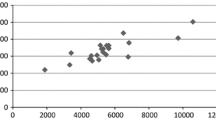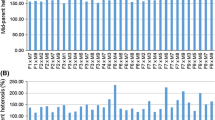Summary
In Trinidad, maize (Zea mays L.) is primarily harvested in the immature stage as green ears for human consumption. The purchase of popular imported hybrid seed has become a substantial component of the economic inputs of maize production. The objectives of this study were to investigate combining abilities and heterotic patterns among available open-pollinated varieties and to assess correlations among five important traits: time to silking, plant height, grain yield, ear size, and marketable ears per hectare. General combining ability was significant for all traits. Specific combining ability was significant for all traits except ear size. Three intervarietal crosses showed moderate levels of heterosis (10–27%), and several yielded similarly to the control hybrids, Pioneer X304 and Pioneer 3078. The cross Acid Soil Tolerant 1991 SA-3 X ICTA Farm Corn was selected as the most suitable base population for mass selection. Phenotypic and genotypic correlations among the five traits studied were all positive and significant. Populations which flowered early were shorter and yielded less than the late flowering and taller populations and population crosses included in this study.
Similar content being viewed by others
References
Aastveit, A.H. & Aastveit, K. 1993. Effects of genotype-environment interactions on genetic correlations. Theoretical and Applied Genetics 86: 1007–1013.
Anon. 1978. Report on maize research project for Jamaica, Trinidad and Tobago, Barbados, Belize, and Guyana. ‘Preliminary investigations into the viability and desirability of local maize production in the above territories’. Chapter 3: Trinidad and Tobago. University of the West Indies, St. Augustine, Trinidad.
Baker, R.J. 1978. Issues in diallel analysis. Crop Science 18: 533–536.
CADP. 1973. Chaguaramas Agricultural Development Project. Annual report-1973. Ministry of Agriculture, Lands and Fisheries, Trinidad.
CADP. 1976. Chaguaramas Agricultural Development Project: Piarco Corn and Soya Project. Annual report-1976. Ministry of Agriculture, Lands and Fisheries, Trinidad.
CIMMYT. 1984. CIMMYT report on maize improvement 1980–81. CIMMYT, El Batán, Mexico.
CIMMYT. 1987. CIMMYT Report on Maize Improvement 1982–83. CIMMYT, El Batán, Mexico.
Cropper, J. (ed.) 1974. Texaco Food Crops Farm Report-The first decade. A review of work on the project from 1964 to 1973. Department of Agricultural Economics and Farm Management. U.W.I., St. Augustine. Trinidad.
Falconer, J.S. 1981. Introduction to quantitative genetics. 2nd. ed. Longman, New York, USA.
Gardner, C.O. & Eberhart, S.A. 1966. Analysis and interpretation of the variety cross diallel and related populations. Biometrics 22: 439–452.
Gooding, H.J. 1960. Yields of West Indian Maize. Tropical Agriculture (Trinidad) 37: 257–264.
Hallauer, A.R. & Miranda, F.O. 1988. Quantitative genetics in maize breeding. Iowa State University Press, Ames, USA.
Hébert, D., Fauré, S., & Olivieri, I. 1994. Genetic, phenotypic, and environmental correlations in black medic, Medicago lupulina L., grown in three different environments. Theoretical and Applied Genetics 88: 604–613.
IITA (International Institute of Tropical Agriculture). 1986. Annual report and research highlights. Ibadan, Nigeria. ISSN 0331-4340.
Negassa, A., Tolessa, B., Franzel, S., Gedeno, G., and Dadi, L. 1991. The introduction of an early maturing maize (Zea mays) variety to a mid-altitude farming system in Ethiopia. Experimental Agriculture 27: 375–383.
Ramsaran, S. 1992. Final report corn project 1992. Diversification Department. Caroni (1975) Ltd., Trinidad.
SAS (1988). SAS Procedures Guide, Release 6.03 Edition. SAS Institute Inc., Cary, NC, USA.
Spaner, D., Brathwaite, R.A.I., & Mather, D.E. (1995). Evaluation of open-pollinated maize varieties in Trinidad. Plant Varieties and Seeds 8: 125–134.
Steel, R.G.D., & Torrie, J.H. 1980. Principles and procedures of statistics. McGraw-Hill, New York, USA.
Vasal, S.K., G. Srinivasan, J. Crossa, & Beck, D.L. 1992. Heterosis and combining ability of CIMMYT's subtropical and temperate early-maturity maize germplasm. Crop Science 32: 884–890.
Vasal, S.K., G. Srinivasan, S. Pandey, F. Gonzalez C. & Crossa, J. 1993. Heterosis and combining ability of CIMMYT's quality protein maize germplasm: I. Lowland tropical. Crop Science 33: 46–51.
Author information
Authors and Affiliations
Rights and permissions
About this article
Cite this article
Spaner, D., Brathwaite, R.A.I. & Mather, D.E. Diallel study of open-pollinated maize varieties in Trinidad. Euphytica 90, 65–72 (1996). https://doi.org/10.1007/BF00025161
Received:
Accepted:
Issue Date:
DOI: https://doi.org/10.1007/BF00025161




